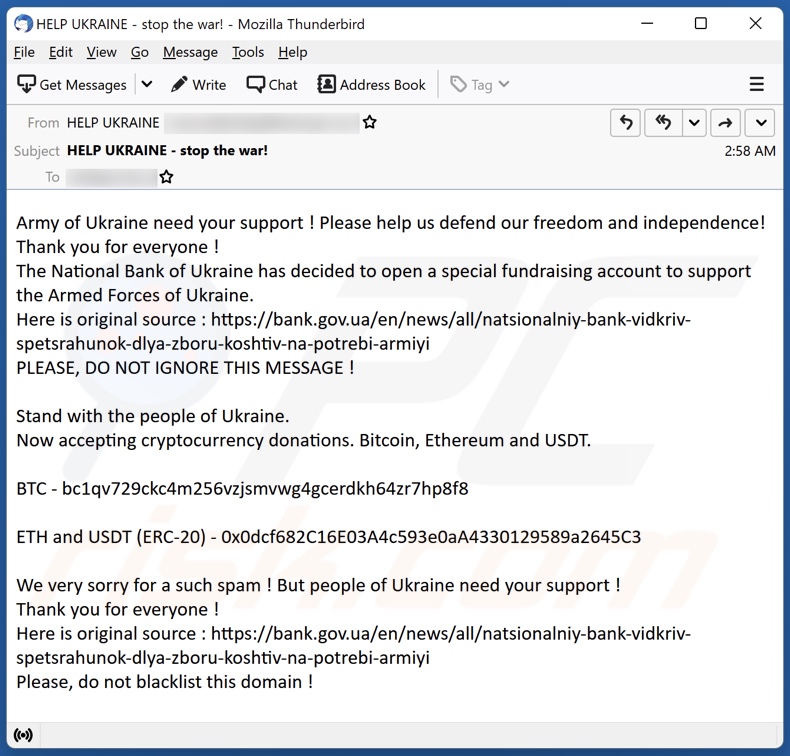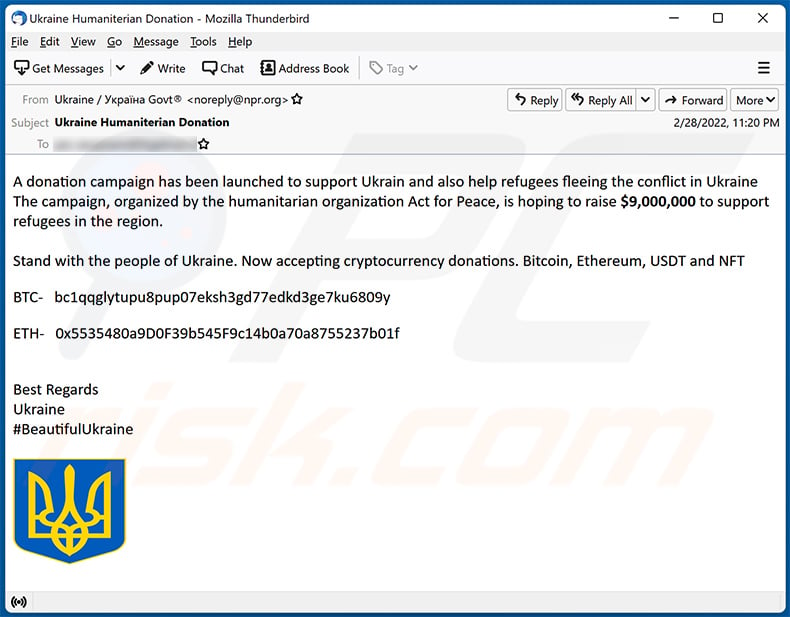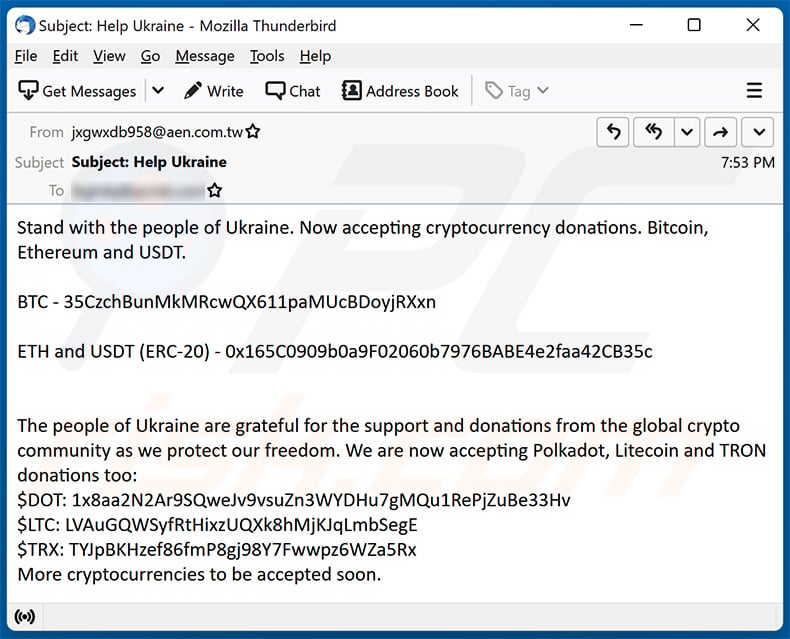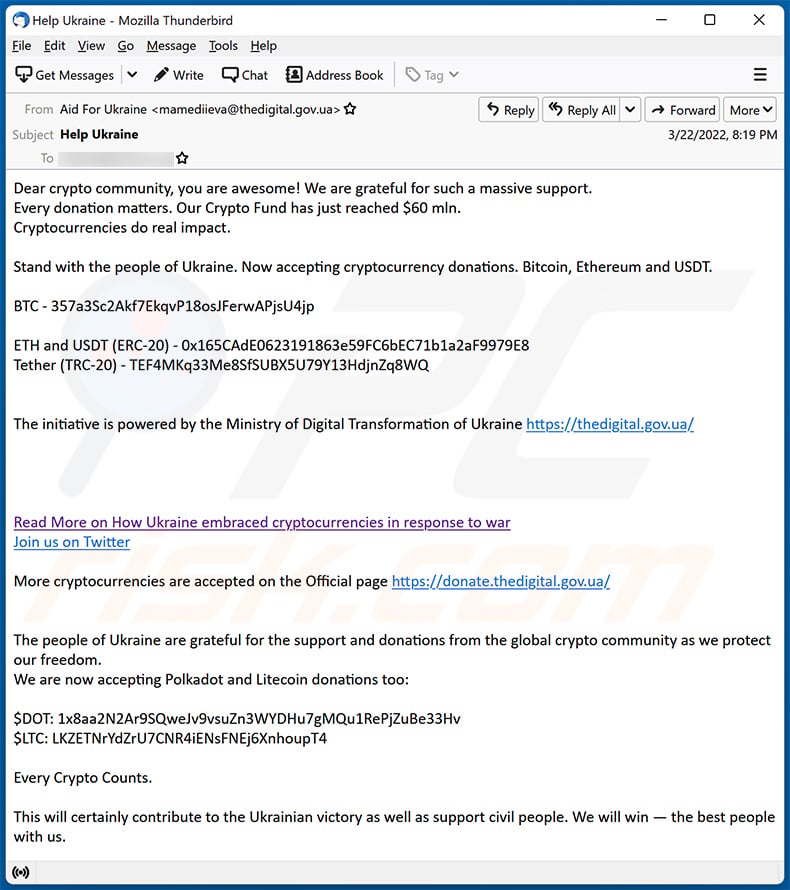Do not donate through fake "Army of Ukraine need your support" emails
Phishing/ScamAlso Known As: Army of Ukraine need your support spam email
Get free scan and check if your device is infected.
Remove it nowTo use full-featured product, you have to purchase a license for Combo Cleaner. Seven days free trial available. Combo Cleaner is owned and operated by RCS LT, the parent company of PCRisk.com.
What is the "Army of Ukraine need your support" scam email?
"Army of Ukraine need your support" is a scam email our researchers discovered and analyzed. This fake letter urges recipients to donate to the Ukrainian army in their efforts to protect their country's independence. With the onset of war in Ukraine, cyber criminals have taken to abusing these harrowing events for profit.
It must be emphasized that this email is a scam, and by trusting it - users will send funds to scammers rather than those in need.
We strongly recommend using official channels to make donations. Do not use those promoted through unsolicited emails, text messages (SMSes), or similar - without extensively researching them. Even if the sources check out, we still advise against accessing the donation channels through such mail.

"Army of Ukraine need your support" email scam overview
The spam email with the subject line "HELP UKRAINE - stop the war!" (may vary) requests recipients to support the Ukrainian army. It states that the National Bank of Ukraine has opened a fundraising account for the Armed Forces of Ukraine. Alternatively, the letter informs that donations in Bitcoin, Ethereum, and Tether (USDT) cryptocurrencies are also accepted.
As mentioned in the introduction, the information provided by this letter is false. The donation options listed in it are fake. Therefore, the funds transferred to this scam will not reach the proclaimed recipients.
This scam email is a perfect example of how cyber criminals abuse ongoing crises to generate revenue. They often incorporate genuine details and actual news in their scams in order to increase the impression of legitimacy. In the case of "Army of Ukraine need your support" spam email, scammers use the fact that the Ukrainian government has begun accepting donations in cryptocurrencies.
To summarize, do not donate to the accounts/wallets listed in this email (or ones provided by similarly suspicious mail). We encourage you to research possible donation options and use only official channels to donate.
If you have already transferred funds to dubious entities, you might be able to stop the transactions if you made them with your bank. Hence, you should immediately contact your bank's official support.
However, if you have transferred cryptocurrency - reversing any transactions is most likely impossible. Cryptocurrency transactions are difficult to trace, which makes them virtually irreversible.
| Name | Army of Ukraine need your support spam email |
| Threat Type | Phishing, Scam, Social Engineering, Fraud |
| Disguise | Scam email urges recipients to transfer funds to the cyber criminals by claiming that it is in effort to support the Ukrainian army. |
| Cyber Criminal Cryptowallet Addresses | bc1qv729ckc4m256vzjsmvwg4gcerdkh64zr7hp8f8 (Bitcoin), bc1qqglytupu8pup07eksh3gd77edkd3ge7ku6809y (Bitcoin), 1J4x3a7fmihrSjfEPmHhcRsXzd2qBuMr2s (Bitcoin), bc1q0e29jp5ttc6zq7tmv6je640075598sevuqudr8 (Bitcoin), 35CzchBunMkMRcwQX611paMUcBDoyjRXxn (Bitcoin), 0x0dcf682C16E03A4c593e0aA4330129589a2645C3 (Ethereum and Tether), 0x165CAdE0623191863e59FC6bEC71b1a2aF9979E8 (Ethereum and Tether), 0x5535480a9D0F39b545F9c14b0a70a8755237b01f (Ethereum), 0x93f78F10A2e9Da08dBdB9f2a08469331634E17E2 (Ethereum), 0x548904c53480e3811b4253022AFc8E8db5e9941E (Ethereum), 0x165C0909b0a9F02060b7976BABE4e2faa42CB35c (Ethereum and Tether), 1x8aa2N2Ar9SQweJv9vsuZn3WYDHu7gMQu1RePjZuBe33Hv (DOT), LVAuGQWSyfRtHixzUQXk8hMjKJqLmbSegE (LTC), TYJpBKHzef86fmP8gj98Y7Fwwpz6WZa5Rx (TRX), TEF4MKq33Me8SfSUBX5U79Y13HdjnZq8WQ (Tether) |
| Symptoms | Unauthorized online purchases, changed online account passwords, identity theft, illegal access of the computer. |
| Distribution methods | Deceptive emails, rogue online pop-up ads, search engine poisoning techniques, misspelled domains. |
| Damage | Loss of sensitive private information, monetary loss, identity theft. |
| Malware Removal (Windows) |
To eliminate possible malware infections, scan your computer with legitimate antivirus software. Our security researchers recommend using Combo Cleaner. Download Combo CleanerTo use full-featured product, you have to purchase a license for Combo Cleaner. 7 days free trial available. Combo Cleaner is owned and operated by RCS LT, the parent company of PCRisk.com. |
Spam campaigns in general
Cyber criminals commonly use the current world climate as a backdrop for their scams. We have written about countless scam emails centered on the COVID-19 pandemic; "Covid-19 stimulus payment", "Coronavirus Track and trace result", "RedCross Email Scam", and "URGENT INFORMATION ON COVID-19 VACCINATION" - are just a few examples.
Spam emails can have a wide variety of disguises and aims. For example, phishing letters about account-related issues targeting their usernames/passwords, lottery and inheritance themed ones seeking personally identifiable information and/or payments for bogus services, sextortion scams falsely claiming to have explicit content and ransoming it, work and business centered emails aiming to collect private data or to infect systems with malware, and many others.
"New Contract Documents Received", "Your Account Needs Attention!", "Habib Bank AG Zurich Email Scam", "Download all your blocked email messages", and "I have been watching you" are some of the most recent spam campaigns we have analyzed.
Due to the prevalence of this deceptive mail, we advise exercising caution with incoming emails and messages.
How do spam campaigns infect computers?
Spam emails can have virulent files as attachments or download links. These files can be archives (ZIP, RAR, etc.), executables (.exe, .run, etc.), PDF and Microsoft Office documents, JavaScript, and so on. When a malicious file is opened - the infection chain is triggered.
For example, MS Office documents opened in Microsoft Office versions released prior to 2010 immediately execute malicious macro commands that initiate malware download/installation. Later Microsoft Office versions have "Protected View" mode, and users can only enable macros manually (i.e., allow editing/content). However, many infectious documents contain deceptive messages to trick users into enabling macro commands.
How to avoid installation of malware?
We strongly advise against opening the attachments and links present in suspicious/irrelevant emails, as they can contain malware. Additionally, it is important to use Microsoft Office emails released after 2010.
However, malicious software is not proliferated exclusively via spam mail. Therefore, we also recommend downloading only from official and verified sources. Furthermore, all programs must be activated and updated with tools provided by legitimate developers, as those obtained from third-parties may be laced with malware.
We must emphasize the importance of having a reputable anti-virus installed and kept updated. Security software must be used to run regular system scans and to remove detected threats. If you've already opened malicious attachments, we recommend running a scan with Combo Cleaner Antivirus for Windows to automatically eliminate infiltrated malware.
Text presented in the "Army of Ukraine need your support" scam email letter:
Subject: HELP UKRAINE - stop the war!
Army of Ukraine need your support ! Please help us defend our freedom and independence!
Thank you for everyone !
The National Bank of Ukraine has decided to open a special fundraising account to support the Armed Forces of Ukraine.
Here is original source : hxxps://bank.gov.ua/en/news/all/natsionalniy-bank-vidkriv-spetsrahunok-dlya-zboru-koshtiv-na-potrebi-armiyi
PLEASE, DO NOT IGNORE THIS MESSAGE !
Stand with the people of Ukraine.
Now accepting cryptocurrency donations. Bitcoin, Ethereum and USDT.
BTC - bc1qv729ckc4m256vzjsmvwg4gcerdkh64zr7hp8f8
ETH and USDT (ERC-20) - 0x0dcf682C16E03A4c593e0aA4330129589a2645C3
We very sorry for a such spam ! But people of Ukraine need your support !
Thank you for everyone !
Here is original source : hxxps://bank.gov.ua/en/news/all/natsionalniy-bank-vidkriv-spetsrahunok-dlya-zboru-koshtiv-na-potrebi-armiyi
Please, do not blacklist this domain !
Another example of Ukraine support-themed scam email:

Text presented within:
Subject: Ukraine Humaniterian Donation
A donation campaign has been launched to support Ukrain and also help refugees fleeing the conflict in Ukraine
The campaign, organized by the humanitarian organization Act for Peace, is hoping to raise $9,000,000 to support refugees in the region.Stand with the people of Ukraine. Now accepting cryptocurrency donations. Bitcoin, Ethereum, USDT and NFT
BTC- bc1qqglytupu8pup07eksh3gd77edkd3ge7ku6809y, bc1q0e29jp5ttc6zq7tmv6je640075598sevuqudr8
ETH- 0x5535480a9D0F39b545F9c14b0a70a8755237b01f, 0x548904c53480e3811b4253022AFc8E8db5e9941E
Best Regards
Ukraine
#BeautifulUkraine
Yet another example of Ukraine support-themed scam email:

Text presented within:
Subject: Subject: Help Ukraine
Stand with the people of Ukraine. Now accepting cryptocurrency donations. Bitcoin, Ethereum and USDT.BTC - 35CzchBunMkMRcwQX611paMUcBDoyjRXxn, 1J4x3a7fmihrSjfEPmHhcRsXzd2qBuMr2s
ETH and USDT (ERC-20) - 0x165C0909b0a9F02060b7976BABE4e2faa42CB35c, 0x93f78F10A2e9Da08dBdB9f2a08469331634E17E2
The people of Ukraine are grateful for the support and donations from the global crypto community as we protect our freedom. We are now accepting Polkadot, Litecoin and TRON donations too:
$DOT: 1x8aa2N2Ar9SQweJv9vsuZn3WYDHu7gMQu1RePjZuBe33Hv
$LTC: LVAuGQWSyfRtHixzUQXk8hMjKJqLmbSegE
$TRX: TYJpBKHzef86fmP8gj98Y7Fwwpz6WZa5Rx
More cryptocurrencies to be accepted soon.
Another example of the Ukrainian-Russian war-themed spam email:

Text presented within:
Subject: Help Ukraine
Dear crypto community, you are awesome! We are grateful for such a massive support.
Every donation matters. Our Crypto Fund has just reached $60 mln.
Cryptocurrencies do real impact.Stand with the people of Ukraine. Now accepting cryptocurrency donations. Bitcoin, Ethereum and USDT.
BTC - 357a3Sc2Akf7EkqvP18osJFerwAPjsU4jp
ETH and USDT (ERC-20) - 0x165CAdE0623191863e59FC6bEC71b1a2aF9979E8
Tether (TRC-20) - TEF4MKq33Me8SfSUBX5U79Y13HdjnZq8WQ
The initiative is powered by the Ministry of Digital Transformation of Ukraine -Read More on How Ukraine embraced cryptocurrencies in response to war
Join us on TwitterMore cryptocurrencies are accepted on the Official page -
The people of Ukraine are grateful for the support and donations from the global crypto community as we protect our freedom.
We are now accepting Polkadot and Litecoin donations too:$DOT: 1x8aa2N2Ar9SQweJv9vsuZn3WYDHu7gMQu1RePjZuBe33Hv
$LTC: LKZETNrYdZrU7CNR4iENsFNEj6XnhoupT4Every Crypto Counts.
This will certainly contribute to the Ukrainian victory as well as support civil people. We will win — the best people with us.
Instant automatic malware removal:
Manual threat removal might be a lengthy and complicated process that requires advanced IT skills. Combo Cleaner is a professional automatic malware removal tool that is recommended to get rid of malware. Download it by clicking the button below:
DOWNLOAD Combo CleanerBy downloading any software listed on this website you agree to our Privacy Policy and Terms of Use. To use full-featured product, you have to purchase a license for Combo Cleaner. 7 days free trial available. Combo Cleaner is owned and operated by RCS LT, the parent company of PCRisk.com.
Quick menu:
- What is Army of Ukraine need your support spam email?
- Types of malicious emails.
- How to spot a malicious email?
- What to do if you fell for an email scam?
Types of malicious emails:
![]() Phishing Emails
Phishing Emails
Most commonly, cybercriminals use deceptive emails to trick Internet users into giving away their sensitive private information, for example, login information for various online services, email accounts, or online banking information.
Such attacks are called phishing. In a phishing attack, cybercriminals usually send an email message with some popular service logo (for example, Microsoft, DHL, Amazon, Netflix), create urgency (wrong shipping address, expired password, etc.), and place a link which they hope their potential victims will click on.
After clicking the link presented in such email message, victims are redirected to a fake website that looks identical or extremely similar to the original one. Victims are then asked to enter their password, credit card details, or some other information that gets stolen by cybercriminals.
![]() Emails with Malicious Attachments
Emails with Malicious Attachments
Another popular attack vector is email spam with malicious attachments that infect users' computers with malware. Malicious attachments usually carry trojans that are capable of stealing passwords, banking information, and other sensitive information.
In such attacks, cybercriminals' main goal is to trick their potential victims into opening an infected email attachment. To achieve this goal, email messages usually talk about recently received invoices, faxes, or voice messages.
If a potential victim falls for the lure and opens the attachment, their computers get infected, and cybercriminals can collect a lot of sensitive information.
While it's a more complicated method to steal personal information (spam filters and antivirus programs usually detect such attempts), if successful, cybercriminals can get a much wider array of data and can collect information for a long period of time.
![]() Sextortion Emails
Sextortion Emails
This is a type of phishing. In this case, users receive an email claiming that a cybercriminal could access the webcam of the potential victim and has a video recording of one's masturbation.
To get rid of the video, victims are asked to pay a ransom (usually using Bitcoin or another cryptocurrency). Nevertheless, all of these claims are false - users who receive such emails should ignore and delete them.
How to spot a malicious email?
While cyber criminals try to make their lure emails look trustworthy, here are some things that you should look for when trying to spot a phishing email:
- Check the sender's ("from") email address: Hover your mouse over the "from" address and check if it's legitimate. For example, if you received an email from Microsoft, be sure to check if the email address is @microsoft.com and not something suspicious like @m1crosoft.com, @microsfot.com, @account-security-noreply.com, etc.
- Check for generic greetings: If the greeting in the email is "Dear user", "Dear @youremail.com", "Dear valued customer", this should raise suspiciousness. Most commonly, companies call you by your name. Lack of this information could signal a phishing attempt.
- Check the links in the email: Hover your mouse over the link presented in the email, if the link that appears seems suspicious, don't click it. For example, if you received an email from Microsoft and the link in the email shows that it will go to firebasestorage.googleapis.com/v0... you shouldn't trust it. It's best not to click any links in the emails but to visit the company website that sent you the email in the first place.
- Don't blindly trust email attachments: Most commonly, legitimate companies will ask you to log in to their website and to view any documents there; if you received an email with an attachment, it's a good idea to scan it with an antivirus application. Infected email attachments are a common attack vector used by cybercriminals.
To minimise the risk of opening phishing and malicious emails we recommend using Combo Cleaner Antivirus for Windows.
Example of a spam email:

What to do if you fell for an email scam?
- If you clicked on a link in a phishing email and entered your password - be sure to change your password as soon as possible. Usually, cybercriminals collect stolen credentials and then sell them to other groups that use them for malicious purposes. If you change your password in a timely manner, there's a chance that criminals won't have enough time to do any damage.
- If you entered your credit card information - contact your bank as soon as possible and explain the situation. There's a good chance that you will need to cancel your compromised credit card and get a new one.
- If you see any signs of identity theft - you should immediately contact the Federal Trade Commission. This institution will collect information about your situation and create a personal recovery plan.
- If you opened a malicious attachment - your computer is probably infected, you should scan it with a reputable antivirus application. For this purpose, we recommend using Combo Cleaner Antivirus for Windows.
- Help other Internet users - report phishing emails to Anti-Phishing Working Group, FBI’s Internet Crime Complaint Center, National Fraud Information Center and U.S. Department of Justice.
Frequently Asked Questions (FAQ)
Why did I receive this email?
Spam emails are not personal. Cyber criminals send them by the thousand with the hopes that at least some of the recipients will be tricked by their scams.
I have sent funds to the accounts/wallets presented this email, can I get my money back?
Whether the money can be returned depends on the method used to transfer them. If you have used your bank, you might be able to reverse the transaction if you immediately contact the bank's official support. However, if you transferred cryptocurrency - doing so is likely impossible. Cryptocurrency transactions are difficult to trace - and as such - are practically irreversible.
I have provided my personal information when tricked by this spam email, what should I do?
If you have disclosed private data like ID card details, credit card numbers, or similar - contact the corresponding authorities without delay. And if you have provided account details - immediately change the passwords of all potentially exposed accounts and inform their official support.
I have read a spam email but didn't open the attachment, is my computer infected?
No, just reading a spam email is not enough to inadvertently initiate malware download/installation. Infection processes are triggered when the attachments or links present in this mail - are opened/clicked.
I have downloaded and opened a file attached to a spam email, is my computer infected?
If the opened file was an executable (.exe, .run, etc.) - they jumpstart infection processes when opened almost without fail. However, you might have avoided infecting your device if it was a document (.doc, .xls, .pdf, etc.). These formats may require additional user interaction (e.g., enabling macro commands - allowing editing/content, etc.) - to begin downloading/installing malicious software.
Will Combo Cleaner remove malware infections present in email attachments?
Yes, Combo Cleaner can detect and eliminate most of the known malware infections. It must be stressed that performing a complete system scan is crucial - since high-end malicious programs usually hide deep within systems.
Share:

Tomas Meskauskas
Expert security researcher, professional malware analyst
I am passionate about computer security and technology. I have an experience of over 10 years working in various companies related to computer technical issue solving and Internet security. I have been working as an author and editor for pcrisk.com since 2010. Follow me on Twitter and LinkedIn to stay informed about the latest online security threats.
PCrisk security portal is brought by a company RCS LT.
Joined forces of security researchers help educate computer users about the latest online security threats. More information about the company RCS LT.
Our malware removal guides are free. However, if you want to support us you can send us a donation.
DonatePCrisk security portal is brought by a company RCS LT.
Joined forces of security researchers help educate computer users about the latest online security threats. More information about the company RCS LT.
Our malware removal guides are free. However, if you want to support us you can send us a donation.
Donate
▼ Show Discussion